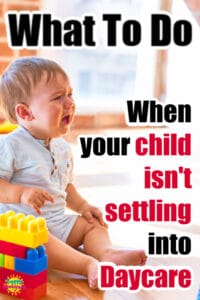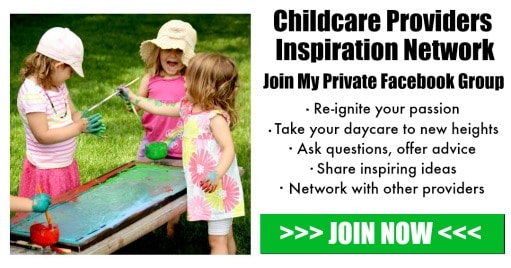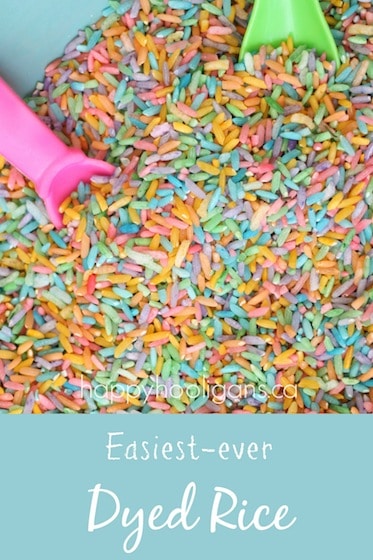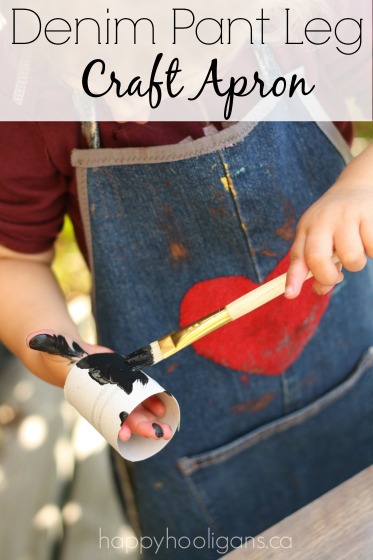If your child isn’t settling into daycare, it can be stressful, heartbreaking and emotionally exhausting for baby, parent and the care provider. Here are some simple things you can do to help your baby or toddler adjust to a new daycare setting.

A friend once told me that parenting is not for the faint of heart and there was no time more evident of that than when she was struggling with her oldest child settling in at daycare.
Because I run a home daycare, she called me for advice.
Since her son was new to daycare, he was experiencing a great deal of separation anxiety whenever she or her husband dropped him off at the daycare. By the end of the first month, he still wasn’t comfortable and would cry every time she left him.
Every single day was a battle.
If you’ve ever experienced the wail of a child who is struggling with separation anxiety, you know how heart-wrenching it can be.
I told her that most of it was just a matter of time, love, patience, and consistency. Talking to the daycare provider(s) about finding ways to help the child with the transition is important, but there are some simple steps you can take that will help your child settle in and become comfortable in his or her new environment.
Advice from real parents and providers
I wanted to share some advice of my own, as well as several suggestions from parents in the Happy Hooligans Facebook community. Their advice is always valuable because they’re real parents who have been there and come through on the other side.
If your child is having trouble settling in to daycare or experiencing separation anxiety when you leave him or her with a babysitter, try some of these mom and teacher-tested suggestions and solutions.
Create a Picture Routine
Knowing what to expect, and when to expect it, can help to reduce your child’s anxiety. Children find comfort in routine and structure. It’s no different for children with a new school routine. With the help of your child’s teacher, snap pictures of your child’s daily schedule and create a mini-picture album.
Related: How to Help Kids with Bedtime Anxiety
Your child will be able to flip through the book to see what the structure of their day looks like. You can also include pictures of your toddler’s morning routine at home, to help him overcome the anxiety that builds before you leave the house.
Something that Smells like Home
Many caregivers, including myself, have found it very helpful for the child to have one of Mom’s or Dad’s tee shirts to carry and cuddle. A favourite blankie or stuffed animal that smells like home can do the same. In the first few days when the child is settling in, the child can have their special item as often as they want or need it. As they settle and gain confidence in their new surroundings, their need for the item gradually decreases and they may just want it at nap time.
Have a Family Board
If your daycare doesn’t have a Family Board, ask if you can start one. Use a small bulletin board and staple pictures of students’ families to it. Hang the bulletin board at children’s eye-level and place it in a special section of the classroom.
Some comfortable seating and a cozy rug make this a comforting space for little ones to visit when they’re feeling particularly sad about missing their families. If your daycare can’t accommodate a Family Board, ask if your child can keep a picture of his family in his cubby.
Avoid Big Changes at Home
Big changes at home can add to your child’s stress levels, so it’s important, if possible to keep your child’s routine at home as normal and consistent as possible while they’re settling into daycare.
While some changes, like moving to a new house, can be inevitable (perhaps this is even the reason for the new daycare), try not to add more stressors to your child’s life while they’re adjusting to their new routine at daycare.
Wait to start potty training, moving from a toddler bed or redecorating their room until they’re content and confident with their new care provider. Avoid pacifier weaning, getting a new pet, having a lot of company or going on a trip during this transition stage, as well.
Always Let Your Child Know What’s Next
When you are on your way to daycare, be sure to give your child the plan for the day: “I’m going to work, so you get to play with your friends today! You are having chicken nuggets for lunch, so that’s going to be yummy! I bet you will sing the ABC song, too. When I pick you up later, I will take you home and we will play on the swing set before dinner.”
Always say goodbye to your child (never sneak away) and let them know you’ll be back. Don’t make a BIG deal about leaving. Keep it light, and keep it quick. The longer you linger, the more upset your child will get. A quick hug and kiss and “Have a great day! Love you. See you in a few hours.” is perfect. Being cheerful and happy as you say goodbye will help your child understand that everything is ok.
The Kissing Hand Technique
This idea is based on the book “The Kissing Hand” by Audrey Penn, which is a terrific book to read to your child if they’re experiencing separation idea. You can kiss your child’s hand, or draw a heart or a smiley face on it, and when the child misses you, they can look at their hand or hold it against their cheek.
Related: DIY Worry Stones for Separation Anxiety
Be Patient and Consistent
The best advice that many of our community members gave was to be patient and consistent. It can take a while for a child to settle in to a new situation. “It usually takes about 2 or 3 weeks for a toddler to feel comfortable,” said Priscilla S. “Hang in there, because one day you will suddenly notice him happily playing and not crying.”
For mom and dad, that means being consistent with attendance, a positive attitude and a loving goodbye.
Give yourself grace
When your child is not settling in to daycare, it can make you question everything from your career to your parenting skills. The good news is that it does get better; patience and consistency really will pay off.
Hang in there! Before you know it, your child will be happy and tear-free when you drop them off at daycare, and hardly look back as they toddle off to play with their friends.
You may also enjoy:
When Your Baby Won’t Take a Bottle
When Your Child Can’t Make Friends

Jackie is a mom, wife, home daycare provider, and the creative spirit behind Happy Hooligans. She specializes in kids’ crafts and activities, easy recipes, and parenting. She began blogging in 2011, and today, Happy Hooligans inspires more than 2 million parents, caregivers and Early Years Professionals all over the globe.









kaylie leanne squire
This post is the greatest thing. I am struggling with my daughter and playgroup. Having been through covid just after giving birth, bringing a baby up in confinement and now having her (2years old) going to playgroup 5 days a week has been the hardest and most stressful time yet. This post really made me feel its all going to be ok. Thankyiu so much for the advice and keep doing what your doing. If it has helped me im sure its helped thousands more xx
Jackie Currie
I’m so glad you found the post reassuring, Kaylie. Covid has certainly made it challenging when it comes to socializing young children and introducing them to new settings. I hope your daughter settles in at playgroup soon. x
M share
My daughter is 16 months old and are we putting pressure on her to adjust for new things and to act normally by putting her through this process? She is crying badly and that is making me feel sad . I feel like she is not ready .please share your opinion